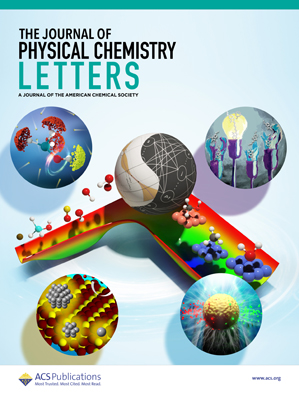Controlling Triplet-Harvesting Pathways and Nonlinear Optical Properties in Cu(I) Iodide-Based Polymers through Ligand Engineering
IF 4.6
2区 化学
Q2 CHEMISTRY, PHYSICAL
引用次数: 0
Abstract
Organic–inorganic hybrid metal halides have become enormously important in optoelectronics, sensing, photosensitization, etc. In this study, we report a structural transition from a staircase configuration to a cubane configuration in Cu(I) iodide-based polymers influenced by the coordination behavior of two different π*-acceptor ligands. The staircase polymer structure, coordinated with 3-cyanopyridine, demonstrates efficient thermally activated delayed fluorescence from (metal+halide)-to-ligand charge transfer [1/3(M+X)LCT] states, with a singlet–triplet energy splitting of ∼9 meV. Conversely, upon replacement of the cyano with an amino group at the same position, a one-dimensional polymeric structure of Cu4I4 cubane-type clusters is formed, which shows strong cluster-centered (3CC) orange emission at room temperature. Temperature-dependent photoluminescence studies indicate that the 3CC state behaves as a self-trapped excitonic state with significant exciton–phonon coupling having a Huang–Rhys factor of 58.6. Additionally, we report this cubane-type cluster polymer acts as an efficient nonlinear optical material showing third harmonic generation with a χ(3) value of 1.32 × 10–18 m2 V–2 and a laser-induced damage threshold of 25.87 GW/cm2.

通过配体工程控制碘化铜基聚合物的三重态收获途径和非线性光学性质
有机-无机杂化金属卤化物在光电子学、传感、光敏化等领域具有重要的应用价值。在这项研究中,我们报道了在两种不同π*受体配体的配位行为的影响下,碘化Cu(I)基聚合物从阶梯构型到立方构型的结构转变。与3-氰吡啶配位的阶梯聚合物结构显示出从(金属+卤化物)到配体电荷转移[1/3(M+X)LCT]态的高效热激活延迟荧光,具有约9 meV的单重态-三重态能量分裂。相反,在相同位置用氨基取代氰基后,形成Cu4I4立方体型簇的一维聚合物结构,在室温下表现出强烈的簇心(3CC)橙色发射。温度依赖性光致发光研究表明,3CC态表现为自捕获激子态,具有显著的激子-声子耦合,Huang-Rhys因子为58.6。此外,我们报道了这种立方体型簇聚合物作为一种有效的非线性光学材料,具有三次谐波产生,χ(3)值为1.32 × 10-18 m2 V-2,激光诱导损伤阈值为25.87 GW/cm2。
本文章由计算机程序翻译,如有差异,请以英文原文为准。
求助全文
约1分钟内获得全文
求助全文
来源期刊

The Journal of Physical Chemistry Letters
CHEMISTRY, PHYSICAL-NANOSCIENCE & NANOTECHNOLOGY
CiteScore
9.60
自引率
7.00%
发文量
1519
审稿时长
1.6 months
期刊介绍:
The Journal of Physical Chemistry (JPC) Letters is devoted to reporting new and original experimental and theoretical basic research of interest to physical chemists, biophysical chemists, chemical physicists, physicists, material scientists, and engineers. An important criterion for acceptance is that the paper reports a significant scientific advance and/or physical insight such that rapid publication is essential. Two issues of JPC Letters are published each month.
 求助内容:
求助内容: 应助结果提醒方式:
应助结果提醒方式:


